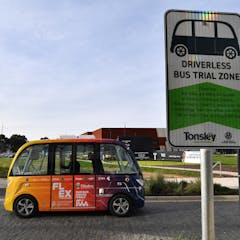
Articles on Autonomous vehicles
Displaying 41 - 60 of 160 articles

Cars that keep your speed within the limit may seem like a good idea, but the prospect of introducing the technology raises some tricky questions.

Autonomous mass transit vehicles like ‘trackless trams’ are a better bet than autonomous cars to give us people-friendly cities that capture the value created by infrastructure for the common good.

Using driverless cars to get from A to B in the future will mean more free time to do other activities – but will people really use it productively?

We’re on the road to developing artificial intelligence systems that will be able to do tasks beyond those they were designed for. But will we be able to control them?

The autonomous rail rapid transit (ART) system developed in China might make buses sexy, but the technology alone won’t resolve the issues of road space and right of way in Australia.

Ensuring that everyone doesn’t charge their cars simultaneously will make a big difference.

The arrival of autonomous vehicles would ideally reduce the number of cars on our roads. But this is a pipe dream without a robust public transport system and willingness to share.

To cut emissions within the 12 years or so we have left to avoid disastrous global warming, we will need to change our old transport habits, using a combination of strategies to achieve this.

New anti-sickness technology is needed for driverless cars to deliver on the promise of letting us read, work or watch films while we travel.

One-third of roads in the U.S. are unpaved; plenty more have faded or obscured road markings. Today’s self-driving vehicles can’t go on them, and will need new algorithms to handle those conditions.

The spread of ride-hailing services and autonomous vehicles will lead to higher energy demand, a study finds. Electric vehicles and a much cleaner grid are the only way to avoid more emissions.

Autonomous cars and people-centered communities are mutually exclusive, writes a cyclist and transportation scholar.

For 40 years the author has argued that trains and trams are better than buses. New ‘trackless trams’, which take innovations from high speed rail and put them in a bus, have changed his mind.

Humans are poor at remaining vigilant over time. That’s bad news for the safety of partially automated cars, which sometimes need the person behind the wheel to quickly take over control.

New research shows how smart aircraft can learn to use updrafts of warm air to stay in the sky.

To maximise the benefits and limit the costs, the use of autonomous vehicles should be pooled and their access to the city restricted.

The debate on autonomous weapons isn’t paying enough attention to the technology already in use.

The UK pioneered smart cards such as Oyster. But now, experimentation is being stifled as cash-strapped councils struggle to deliver basic services.

Autonomous cars need to learn how to drive just like people do: with real-world practice on public roads. It’s key to safety, and to public confidence in the new technologies.

In many US cities, ride-hailing apps are luring riders away from public transit and increasing traffic congestion. But with the right rules, they could enhance public transit instead.





